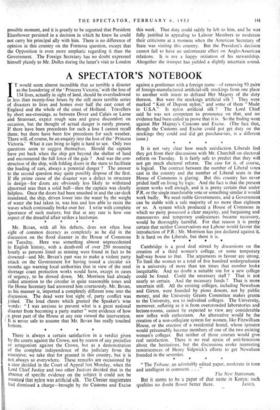A SPECTATOR'S NOTEBOOK
IT would seem almost incredible that so terrible a disaster as the foundering of the ' Princess Victoria,' with the loss of 134 liyes, actually in sight of land, should be overshadowed in less than twenty-four hours by the still more terrible series of disasters to lives and homes over half the east coast of England and the whole of the coast of Holland. Travellers by short sea-crossings, as between Dover and Calais or Larne and Stranraer, expect rough seas and grave discomfort on occasion, but the thought of actual danger is rarely present. If there have been precedents for such a loss I cannot recall them; but there have been few precedents for such weather. There will, of course, be an enquiry into the loss of the ' Princess Victoria.' What it can bring to light is hard to see. Only two questions seem to suggest themselves. Should the captain have put back when the ship got beyond the shelter of land and encountered the full force of the gale ? And was the con- struction of the ship, with folding doors in the stern to facilitate the loading of cars, always a potential danger ? The answer to the second question may quite possibly dispose of the first. If the prime cause of the disaster was a defect in structure in design—for doors are obviously less likely to withstand abnormal seas than a solid hull—then the captain was clearly helpless. Once the doors had been smashed in and the car-deck inundated, the ship, driven lower into the water by the weight of water she had taken in, was less and less able to resist the waves which continually broke over her. I write with complete ignorance of such matters, but that at any rate is how one aspect of the dreadful affair strikes a landsman.


































 Previous page
Previous page